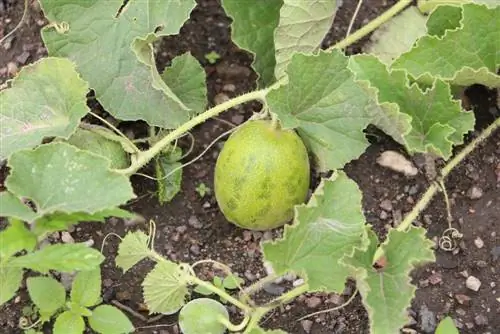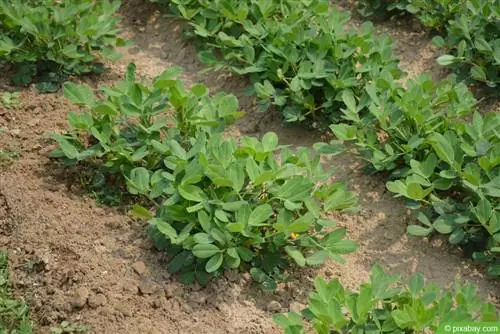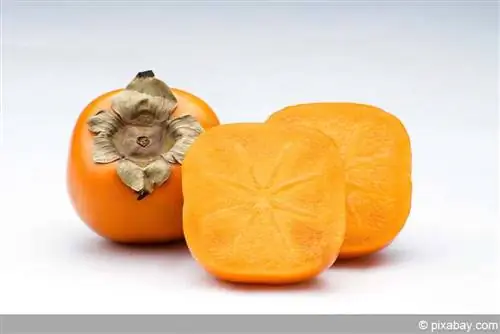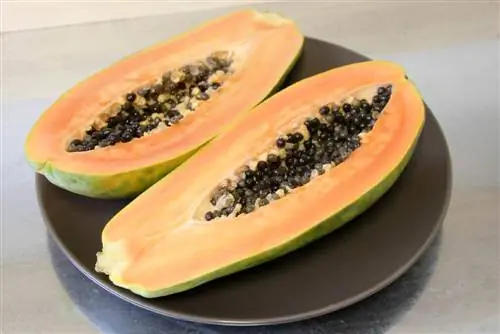- Author admin [email protected].
- Public 2023-12-17 03:39.
- Last modified 2025-01-24 12:45.
The watermelon has the botanical name Citrullus lanatus and originally comes from West Africa. Due to the sweet pulp, this type of fruit is popular all over the world as a delicious snack. Due to the hard shell, the large fruits are easy to transport; melons are often imported from distant countries. Nevertheless, with the right approach, cultivation and breeding are also possible in these latitudes.
Location & Soil
In general, melons place high demands on their location and do not thrive everywhere. Although watermelons belong to the cucurbit family, the plants are much more sensitive to the local cold than native cucumbers and pumpkins. Due to its African origins, the plant depends on warm and bright location conditions. If these conditions are not right, the watermelon cannot grow he althily and will not produce a bountiful harvest. In extreme cases, incorrect location conditions can even cause the entire plant to die.
- A warm and sunny location is ideal
- Needs at least 6 hours of sun exposure per day
- A bed in front of a south wall is well suited
- Prefers humus-rich, permeable and sandy soils
- Make sure the soil is loose and light
- Loosen extremely heavy and clayey soils with sand
- pH value should be between 6 to 7
- Make sure you have a place protected from the wind
- It is essential to avoid cool drafts and strong gusts of wind
- It is optimal to grow in a warm greenhouse
Tip:
In order to guarantee the watermelon a sun-drenched location, it is advisable to set up a raised bed. This way it can grow beautifully in a slightly elevated spot with lots of sunlight.
Sowing & Planting

Sowing and planting the exotic plants is quite easy. However, the heat-loving watermelons do not germinate outdoors in these latitudes because the temperature is too low. Therefore, growing outdoors requires cultivation in sheltered indoor spaces or in greenhouses. When growing, it is important to have enough space in the bed on all sides so that the watermelons and their large fruits can spread out undisturbed. If there is not enough space to grow, the harvest will be significantly smaller.
- Carry out cultivation from seeds at least 21 °C
- Place the cultivation container on a light-flooded windowsill
- Germination time is about 7-14 days
- Let young plants grow for a total of 3-4 weeks
- Plant out into the already warmed bed after the ice saints
- Enrich the soil with plenty of ripe compost beforehand
- Create a drainage layer made of gravel or quartz sand
- Dig a sufficiently large planting hole
- Roots must fit and not bend
- Requires an area of approximately 1 to 2 square meters
- Looks forward to a supportive trellis
- First water only moderately, then increase the water dosage
Note:
When growing, a slow and careful transition from the room to the bright sunlight of the garden is crucial. Therefore, plant the sensitive plants on a cloudy and not too hot day.
Container planting & greenhouse
As an alternative, watermelons can also be grown in a bucket. This makes it possible to grow on a balcony or terrace even without a garden. However, to succeed, a sufficiently large container is required so that the plant can spread well. However, potted plants should not be left in the blazing sun all day, otherwise the soil will dry out too quickly, ruining the harvest. Growing watermelons in a greenhouse is ideal, as temperatures here are pleasantly warm even in spring. In addition, there is no risk of late frost nights, which could lead to the plants dying.
- Compact growing varieties are ideal
- Choose a large container
- Conventional garden soil is not suitable for keeping in containers
- Use nutrient-rich plant substrate instead
- Enrich with a portion of sand and clay
- Compost-based substrates are also suitable
- A partially shaded location on a balcony or terrace is optimal
- Protect plants from strong midday heat
- Grow from seeds in the greenhouse at the beginning of spring
- Ensure adequate ventilation to prevent rot
- Open windows and doors for a few hours every day
- Especially during the flowering phase to allow pollination
Watering & Fertilizing

Watermelons come from tropical countries and require a lot of water. The soil must never dry out completely, otherwise damage will quickly occur and the plant will die. That's why Citrullus lanatus needs to be watered a lot and often, especially in summer. In addition, the water requirement increases when the plant is in the fruiting phase. In addition, watermelons also have high nutritional requirements. Most soils can only meet these requirements to a limited extent. It is therefore advisable to fertilize regularly when growing so that the melons can grow splendidly. If the plants do not receive enough nutrients, the entire harvest may even fail. However, young plants have to wait around four weeks after planting so that they can get used to the new location in peace.
- Water thoroughly every day, preferably in the morning
- Even water twice on hot summer days
- Never use cold tap water
- Stale and lukewarm watering water is better
- Ideally collect rainwater
- Do not wet the leaves, this leads to powdery mildew disease
- Avoid waterlogging at all costs
- Administer nitrogen-containing fertilizers every two weeks
- Organic liquid fertilizer for vegetables is ideal
- As an alternative, organic horse manure is well suited
Tip:
Before fruiting, it is recommended to fertilize once a week to support Citrullus lanatus with additional nutrients.
Fruits & Growth
Melons grow as annual plants, similar to cucumbers and pumpkins, so overwintering is not possible. For this reason, the plants are torn from the ground after harvest and then completely disposed of in the compost heap. Most watermelons have bright red flesh. However, there are also varieties with yellow, green, orange or white flesh, which are mainly available in specialized fruit and vegetable shops. The high water content of the fruit is very refreshing, especially when enjoyed chilled in summer. Since watermelons require a lot of water, the soil is constantly moist. To avoid rotting fruit, it is advisable to place plates made of Styrofoam or similar materials under the melons. In this way, direct contact with the permanently moist soil and the resulting signs of rot can be avoided.
- Plants form thin and angular shoot axes
- Long growth habit with many branched tendrils
- In extreme cases they can grow up to 10 m
- Form pinnate leaves that are hairy on both sides
- Light yellow flowers develop from June onwards
- Then round fruits emerge, sometimes rather elongated
- Fruits consist of 95% water
- Contain lots of vitamins A and C
- Melons continually gain weight
- Can be up to 50 cm thick and weigh up to 20 kg
- Slump down and lie on the floor
- Shell is a hard shell up to 4 cm thick
Harvest time
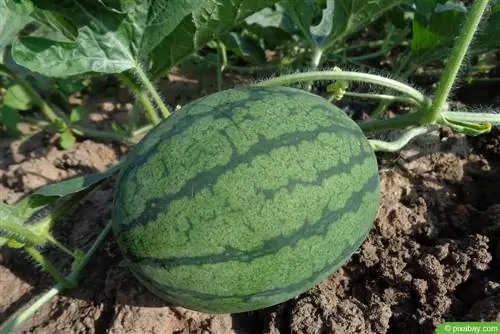
Watermelons have a long ripening time compared to other types of fruit. In order for the large fruits to taste delicious and juicy, melons must ripen sufficiently. The usual sweet taste only develops over time. To determine the ripeness of a watermelon, it is necessary to pay attention to certain signs. This includes a dark green shell with yellowish spots. When you tap on the shell, a dull sound is made and the leaves also begin to wilt. In autumn, the plant parts of the watermelon turn brown before the first frost and then die. This is usually a sign that the fruit is fully ripe. For this reason, from a botanical point of view, Citrullus lanatus should actually be considered a vegetable and not a fruit, since all external parts of the plant die when the fruits ripen.
- Harvest possible from the end of August until autumn
- Size is not a guaranteed indication of ripe fruit
- The contact point of the shell changes color from white to yellow
- Check maturity by knocking
- Separate the fruit from the plant with a sharp knife
- Leave the stems standing, so the tank stays closed longer
- As a result, the melon lasts longer for consumption
- Store at room temperature, but not in the sun
- Uncut fruits can be stored for up to 2 weeks
- Store in the refrigerator after cutting
Diseases & Pests

In general, Citrullus lanatus is a robust plant that grows he althily and splendidly with the correct site conditions and care measures. However, diseases and pests can occur if these factors are imbalanced. The causes are often compacted soil, long-term waterlogging and frequent lack of water. In addition, too high a s alt content in the soil can weaken the immune system of the plants. Particularly in greenhouses, fungi sometimes penetrate the plant via the roots or root collar and lead to premature death. It is therefore recommended to grow resistant and extremely resilient varieties. In addition, crop rotation must be taken into account. Melons must not be grown where other cucurbits grew the previous year. In addition, young melon plants are a delicacy for voracious slugs.
- Fusarium wilt and red spider appear in the greenhouse
- Examine plants regularly to prevent rampant infestation
- Always ensure sufficient humidity
- Beneficial insects are suitable for combating
- These include predatory mites Phytoseiulus persimilis and predatory bugs
- Also use larvae of parasitic wasps, lacewings and hoverflies
- Susceptible to aphids, downy mildew and powdery mildew
- Take protective measures against snail infestation
- Sprinkle chopped straw around the plants
- Put out slug pellets in the bed

